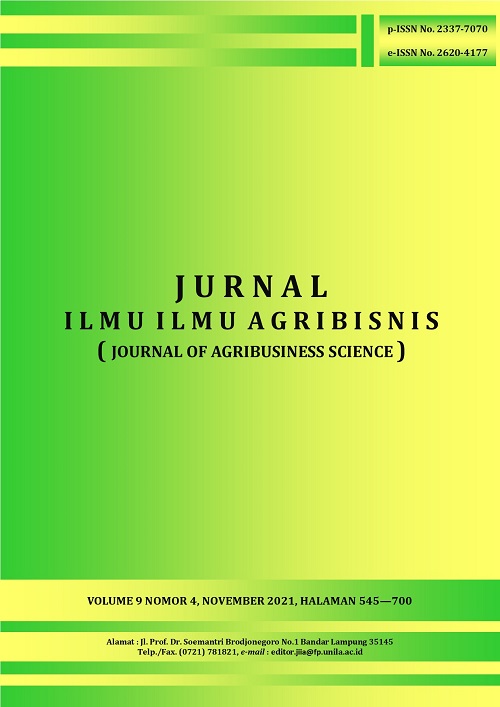PENENTUAN HARGA POKOK PENJUALAN USAHA PENGGEMUKAN SAPI POTONG MITRA DAN NON-MITRA DI DESA ASTOMULYO KECAMATAN PUNGGUR KABUPATEN LAMPUNG TENGAH
DOI:
https://doi.org/10.23960/jiia.v9i4.5399 Abstract View: 374
Abstract View: 374
Abstract
This research aims to find out production main cost, selling main cost, and the differences of production main cost and selling main cost between partner and non-partner cattle fattening business. Furthermore, this research uses cencus method which is conducted on cattle fattening in Astomulyo Village, Punggur Subdistrict, Central Lampung Regency. The location are chosen purposively as the consideration that the Punggur Sub-district, Central Lampung Regency has the largest cattle population in Lampung Province. Data in this research are analyzed using production main cost, selling main cost and independent sample test. The result shows that: the production main cost of cattle fattening partner and non-partner is Rp39,119.17/kg and Rp40,552.24/kg, respectively. Then, the selling main cost of cattle fattening partner and non-partner is Rp39,763.90/kg and Rp40,736.12/kg, respectively. Finally, there is a significant difference in the production main cost and the selling main cost between partner and non-partner cattle fattening business.
Key words: cattle fattening, production main cost, selling main cost
Downloads
Downloads
Published
How to Cite
Issue
Section
License
Authors who publish with this journal agree to the following terms:
Authors retain copyright and grant the journal right of first publication with the work simultaneously licensed under a Creative Commons Attribution License that allows others to share the work with an acknowledgement of the work's authorship and initial publication in this journal.
Authors are able to enter into separate, additional contractual arrangements for the non-exclusive distribution of the journal's published version of the work (e.g., post it to an institutional repository or publish it in a book), with an acknowledgement of its initial publication in this journal.
Authors are permitted and encouraged to post their work online (e.g., in institutional repositories or on their website) prior to and during the submission process, as it can lead to productive exchanges, as well as earlier and greater citation of published work (See The Effect of Open Access).














